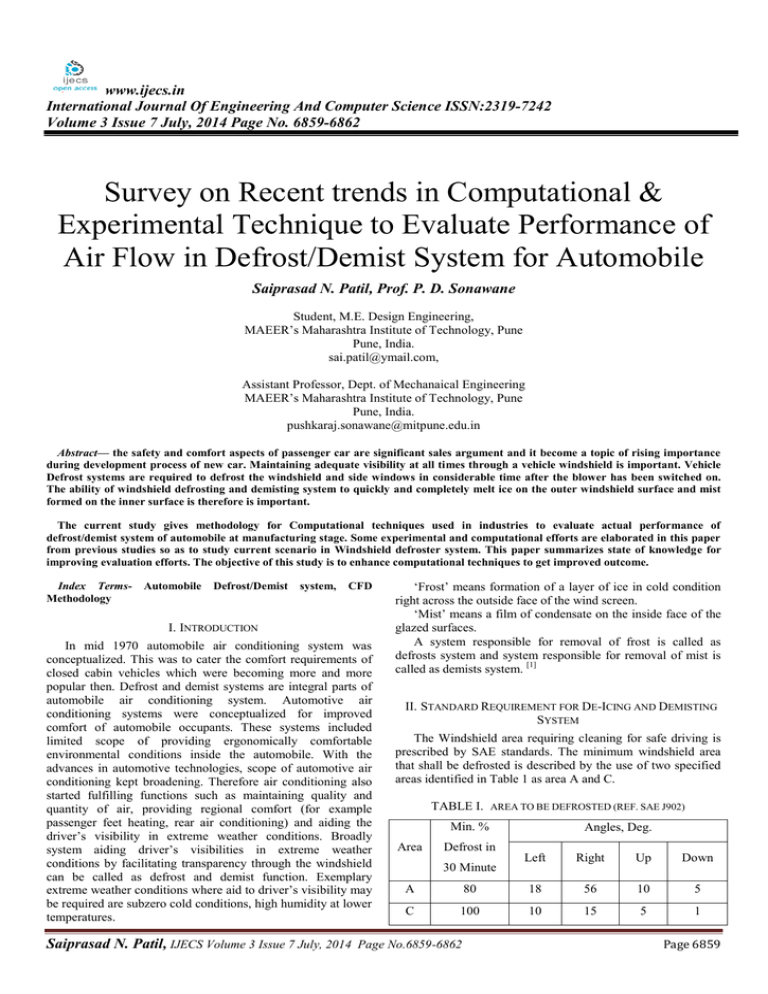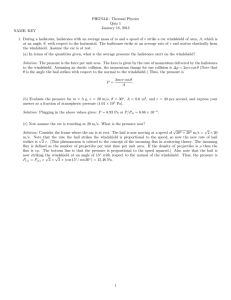www.ijecs.in International Journal Of Engineering And Computer Science ISSN:2319-7242
advertisement

www.ijecs.in International Journal Of Engineering And Computer Science ISSN:2319-7242 Volume 3 Issue 7 July, 2014 Page No. 6859-6862 Survey on Recent trends in Computational & Experimental Technique to Evaluate Performance of Air Flow in Defrost/Demist System for Automobile Saiprasad N. Patil, Prof. P. D. Sonawane Student, M.E. Design Engineering, MAEER‟s Maharashtra Institute of Technology, Pune Pune, India. sai.patil@ymail.com, Assistant Professor, Dept. of Mechanaical Engineering MAEER‟s Maharashtra Institute of Technology, Pune Pune, India. pushkaraj.sonawane@mitpune.edu.in Abstract— the safety and comfort aspects of passenger car are significant sales argument and it become a topic of rising importance during development process of new car. Maintaining adequate visibility at all times through a vehicle windshield is important. Vehicle Defrost systems are required to defrost the windshield and side windows in considerable time after the blower has been switched on. The ability of windshield defrosting and demisting system to quickly and completely melt ice on the outer windshield surface and mist formed on the inner surface is therefore is important. The current study gives methodology for Computational techniques used in industries to evaluate actual performance of defrost/demist system of automobile at manufacturing stage. Some experimental and computational efforts are elaborated in this paper from previous studies so as to study current scenario in Windshield defroster system. This paper summarizes state of knowledge for improving evaluation efforts. The objective of this study is to enhance computational techniques to get improved outcome. Index TermsMethodology Automobile Defrost/Demist system, CFD I. INTRODUCTION In mid 1970 automobile air conditioning system was conceptualized. This was to cater the comfort requirements of closed cabin vehicles which were becoming more and more popular then. Defrost and demist systems are integral parts of automobile air conditioning system. Automotive air conditioning systems were conceptualized for improved comfort of automobile occupants. These systems included limited scope of providing ergonomically comfortable environmental conditions inside the automobile. With the advances in automotive technologies, scope of automotive air conditioning kept broadening. Therefore air conditioning also started fulfilling functions such as maintaining quality and quantity of air, providing regional comfort (for example passenger feet heating, rear air conditioning) and aiding the driver‟s visibility in extreme weather conditions. Broadly system aiding driver‟s visibilities in extreme weather conditions by facilitating transparency through the windshield can be called as defrost and demist function. Exemplary extreme weather conditions where aid to driver‟s visibility may be required are subzero cold conditions, high humidity at lower temperatures. „Frost‟ means formation of a layer of ice in cold condition right across the outside face of the wind screen. „Mist‟ means a film of condensate on the inside face of the glazed surfaces. A system responsible for removal of frost is called as defrosts system and system responsible for removal of mist is called as demists system. [1] II. STANDARD REQUIREMENT FOR DE-ICING AND DEMISTING SYSTEM The Windshield area requiring cleaning for safe driving is prescribed by SAE standards. The minimum windshield area that shall be defrosted is described by the use of two specified areas identified in Table 1 as area A and C. TABLE I. AREA TO BE DEFROSTED (REF. SAE J902) Min. % Area Angles, Deg. Defrost in 30 Minute Left Right Up Down A 80 18 56 10 5 C 100 10 15 5 1 Saiprasad N. Patil, IJECS Volume 3 Issue 7 July, 2014 Page No.6859-6862 Page 6859 For instant, SAE J902 requires that 100% “C” zone and 80% “A” zone of the windshield must be cleared in 30 minutes. FMVSS 103 requires that 80% “C” zone of the windshield must be cleared in 20 minutes as in Figure 1. [2] Outlet Wind Screen Side Windows Velocity Inlet Fig. 2. Geometry of Automobile Fig. 1. Typical Location of Areas 'A' And 'C' As Viewed From Interior Of Vehicle To achieve these de-icing performance standards, several design parameters should be considered, such as defroster nozzle outlet location, air impingement angle, cross-section area of the defroster nozzle and its optimum shape, and finally the number of nozzle outlets needed which depends on the vehicle and the packaging space. Among these parameters, the most significant parameter is the impingement angle and air velocity. These two parameters need to be optimized to insure that the air jet leaving the defroster nozzle travels along the windshield without any significant separation from the windshield. Also, the air circulation between the windshield and the Instrument panel need to be minimized. Considering all this parameters OEM states required air velocity pattern on windshield. Accordingly manufacturers need to design Defrost duct system to fulfill required customer needs. Thus basically manufacturers does not deals with actual windshield defrosting i.e. they are only interested in maintain OEM stated velocity conditions. To evaluate performance of manufactured or in-process parts (Design) various experimental as well as computation techniques are used. In this paper various techniques are explained. Till the date “trial and error” and “prior experience” methods are used in prediction of performance of ventilation and defrosting system. But research and development and increased production efficiency has generated a more interest to develop more sophisticated design tools such as computational fluid dynamics (CFD). Before believing upon CFD for prototype design testing, the computational models must be tuned, tested, and validated. This is especially important when CFD is used in a competitive industry such as the automobile, aeronautical industry. To do this, an extensive and accurate experimental data set of relevant quantities (such as the velocity field, turbulence field, temperature field, etc.) is necessary. Fig. 3. Computational mesh of the Vehicle interior The flow and temperature field on the windows and in the passenger compartment is calculated with many CFD codes like StarCCM+, fluent, powerflow etc. The basic conservation equations, namely the Navier Stokes equations are solved numerically using the finite volume technique as implemented in Fluent. There are many turbulence models which can be employed for numerical prediction. The turbulent nature of the flow is modeled by using standard k-ε model with logarithmic law of the wall. Constant Pressure is specified at the inlet to the defroster nozzles and the side duct, where the air is sucked in. At the slot in the back of the compartment the air is leaving the compartment. The flow is considered as steady, incompressible, viscous, Newtonian and isotropic. [3] The three-dimensional steady-state incompressible Navier Stokes Equations are Mass (continuity) equation: (1) Momentum Equation: (2) III. COMPUTATIONAL FLUID DYNAMICS (CFD) The model of the passenger compartment, including the windshield and side windows of interest here, are drawn using AutoCAD package and then imported for pre-processing as an (IGES). Hypermesh, ANSA, Fluent's T-Grid are used to generate the tetrahedral volume mesh. Energy Equation: (3) Where, ∆ is the Laplacian Operator E is the internal energy per unit mass Saiprasad N. Patil, IJECS Volume 3 Issue 7 July, 2014 Page No.6859-6862 Page 6860 Ф is the rate of dissipation of mechanical energy per unit mass or called more often the viscous dissipation function per unit mass, v is the kinematic viscosity k is the coefficient of thermal conductivity T is the temperature A. Turbulence modelling There are several methods for turbulent flow simulation to numerically close the product of state variables in (1) – (3). One such RNG based standard k-ε turbulence model of Yakhot and Orszag [4] contains the following two equations, one for turbulence kinetic energy k and the other for its dissipation rate ε, respectively (4) (5) The RNG based k-ε turbulence model is derived from the instantaneous Navier –Stokes equations, using a mathematical technique, called “renormalization group” (RNG) methods. The equation (4) and (5), the left hand side shows the diffusion and generation terms and the right hand side involves dissipation rate terms. The turbulent viscosity is modeled as Where Cμ=0.0845 [5]. The standard coefficients are C1ε=1.42 and C2ε=1.68 The turbulent viscosity is not a fluid property, but rather a property of the flow fluid. Its value is added to the molecular viscosity and yields an effective viscosity µeff , which is used in the computational model. The k and ε at the inlet are calculated from the following expression IV. EXPERIMENTAL MEASUREMENT OF VELOCITY DISTRIBUTION ACROSS GLASS SURFACE There are numerous methods of measuring velocities, but most of them rely upon a physical probe being inserted into the airflow of interest. [7] A. Hot Wire Anemometer Hot-wire anemometry provides quantitative velocity measurements that are useful for determining defroster and windshield air flow and validating the numerical simulations. The standard technique to perform hotwire measurements on the windshield entails the use of a Plexiglas template to replace the windshield. It is used in this investigation. A straight hotwire anemometer probe is inserted through the holes of the template. An insertion depth of 7 mm is typically used to account for the growing boundary layer flow field over the windshield. The probe is rotated around its central axis until a maximum signal is detected on the signal processor. The magnitude and direction of the velocity is then determined, with the direction being the normal to the straight hot-wire. [8] To overcome the shortcomings of the standard technique, a modified hot-wire technique was developed to yield more accurate experimental measurements of the velocity field in the vicinity of the defroster nozzle jet flow and windshield inner surface. A complete array of hot-wire results were presented showing consistency with the wall jet velocity profile (in magnitude and direction) due to the impingement of the defroster jet flow on the windshield. Fig. 4. Setup hot-wire anemometer measurement grid on the windshield Where Tu is turbulence level and Lε is a characteristic length. B. Convergence The solution is declared convergent when the maximum residual for each of the state variable is smaller than a convergence criterion of ∈. The convergence of a solution vector U on node n is defined as the norm: Convergence criterion selected for different equations is 10 for continuity, momentum, k, and ε and 10-6 for the energy equation. This convergence criterion was selected as numerical simulations with the criteria resulted in a good correlation with experimental results [6]. Fig. 5. Schematic representation of the standard windshield hot-wire measurement technique (straight hot-wire anemometer is placed at 7mm to the inside of the windshield interior surface) -3 B. Thermal Imaging Thermal imaging is another method to map temperature contours on the windshield of outer surface. It is non instructive method. Instead of direct measurement of air temperature at specific point in space, it measures air temperature range in Saiprasad N. Patil, IJECS Volume 3 Issue 7 July, 2014 Page No.6859-6862 Page 6861 vicinity of windshield. A thermal imaging camera is used to record the thermal evaluation of the windshield flow as well as a video recorder together with a computer system is used for to capturing and analyzing an image obtained. Thermal imaging camera is situated outside the vehicle at a certain distance (let 3m) in front of the plane of windshield. Thermographic system is set before turning on HVAC system. Thermal maps are recorded in time at intervals of 30 seconds from the moments in which heating is turned on. Fig. 6. Thermal Imaging Experimental Setup C. Laser Sheet Evaluation (LSV) Laser Sheet Visualization (LSV) is another method to evaluate flow fields. LSV involves projection on a sheet of laser light which is 2mm thick inside the cabin. Such images are recorded for scattering particles on a single photographic negative or on a video film. An 18 W continuous wave, Argon lon laser is used as light source. The light source is guided to the position of intersect through an optical fibre. A sheet forming optical arrangement is attached to fibre end. Such tracer particles are neutrally buoyant with good light reflection properties. Fig. 7. LSV of the defroster jet flow D. Cold Room Test Facility For cold climatic operation of a vehicle, windshield defrosting system is an important condition. After soaking phase defrosting test is carried out until all vehicle components are cooled down to 18℃ below zero. With the help of uniform spray of very fine water mist (0.044 g/cm2) an ice layer is formed on windshield. The vehicle as well as newly formed ice layers is soaked for further 30-40 minutes before the test begins. [9] V. CONCLUSION This study investigates current experimental and computational techniques to monitor performance of defrost/demist system. In such cases velocity, pressure, temperature etc. of air is monitored. CFD simulation helps to give appropriate results by saving time and computational efforts. Factors such as mesh density, cell geometry, turbulence modeling could impact on speed and accuracy of numerical simulation. CFD tools used for such simulations are very costly. Due to limited node licensing computational time is also restricted. There are few open source tools like „OpenFOAM‟ are available, which will reduce licensing cost and computational time. Thus such open source tools should incorporated for simulation purpose. REFERENCES [1] V. S. Khairatkar, M. Srenivasulu and A. V. Mannikar, “Methodology for Defrost and Demist Test,” SAE Paper No. 2013-26-0062. [2] SAE J902_200307 “Passanger Car Windshield Defrosting System”, SAE Recommended Practice. [3] S. Rasipuram and K. Nasar, “A parametric computationallybased study of windshield heat transfer subjected to impinging airflow,” SAE Paper No.2004-01-1382. [4] V. Yakhot and S. A. Orszag, “Renormalization group analysis of turbulence - Basic Theory,” Journal of Scientific Computing, Vol. 1, 1989, pp 3-51. [5] S. H. Lam, “On the RNG theory of Turbulence,” Physics of Fluids A 4, Vol. 1, 1992, pp. 1007-1017. [6] S. Roy, K. Nasar, P. Patel and B. AbdulNour, “An experimental and numerical study of heat transfer of an inclined surface subjected to an inclined surface subjected to an impinging airflow,” International Journal of Heat and Mass Transfer, Vol. 45, 2002, pp. 1615–1629. [7] A. Aroussi, A. Hassan, B. Clyton and B. AbdulNour, “An Assessment of vehicle side-window defrosting and demisting process,” SAE Paper No. 2001-01-0289. [8] B. S. AbdulNour, 1999, “CFD Prediction of Automotive Windshield Defrost Pattern, Automotive Climate Control Design Elements,” SAE Paper No. 1999-01-1203. [9] B. S. AbdulNour 1997, “Hot-Wire Velocity Measurements of Defroster and Windshield Flow, Automotive Climate Control Design Elements,” SAE Paper No. 970109. Saiprasad N. Patil, IJECS Volume 3 Issue 7 July, 2014 Page No.6859-6862 Page 6862





